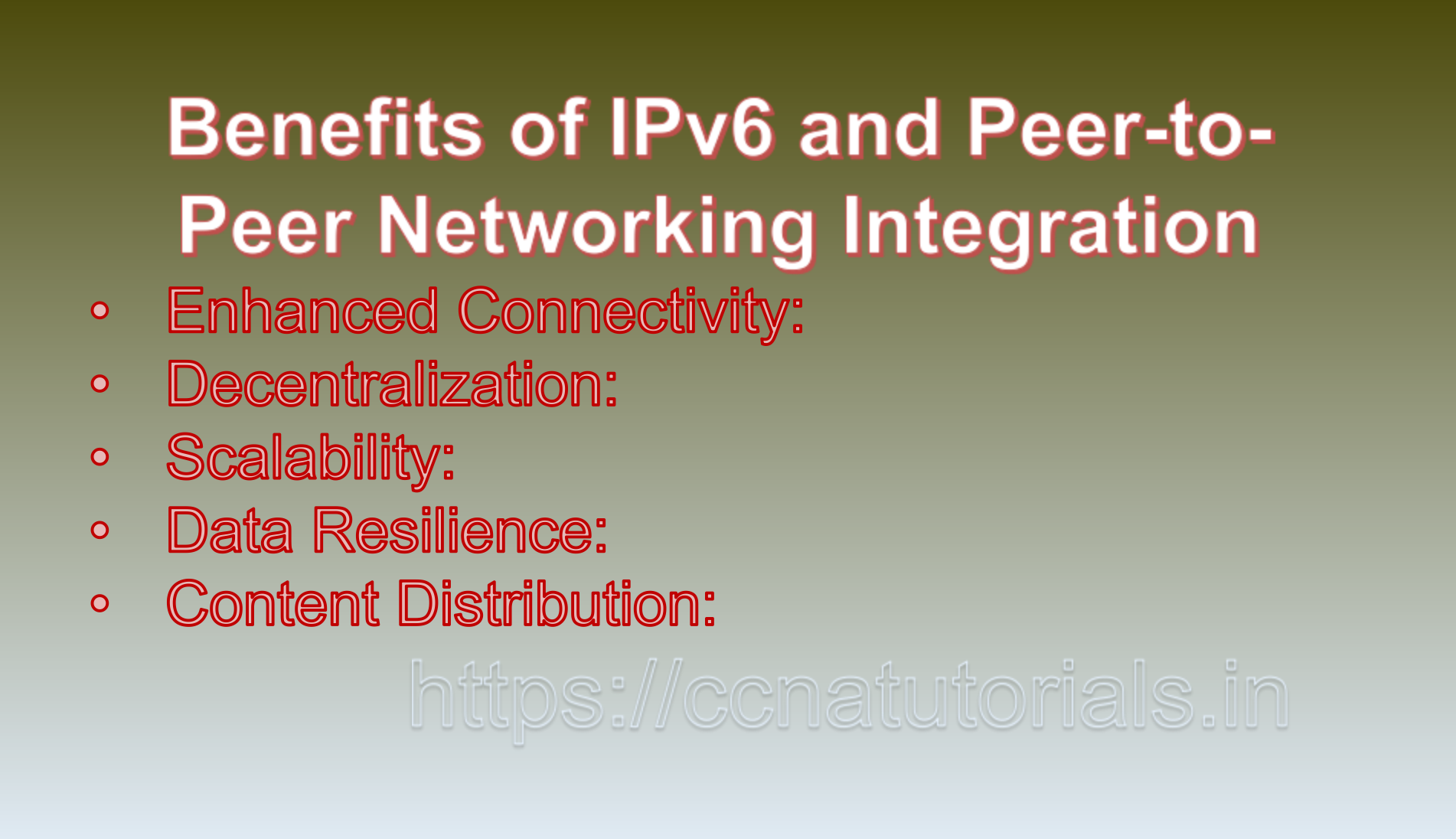Contents of this article
In this article, I describe IPv6 and Peer-to-Peer Networking: Empowering Decentralized Communication and Data Sharing. IPv6 (Internet Protocol version 6) and peer-to-peer (P2P) networking are two transformative technologies that have reshaped the way we communicate and share information over the internet. The integration of IPv6 with P2P networking offers a powerful combination that enables efficient, decentralized, and direct communication between devices. This synergy presents numerous advantages, including improved connectivity, enhanced scalability, and better support for emerging technologies. In this article, we’ll delve into the relationship between IPv6 and P2P networking, explore their benefits, discuss implementation considerations, and provide examples to illustrate their significance in modern networking.
Understanding IPv6 and Peer-to-Peer Networking
IPv6: IPv6 is the next generation of the Internet Protocol, designed to replace IPv4 by addressing its limitations and offering a vastly larger address space. With the proliferation of connected devices, IPv6 ensures that each device can be uniquely identified and accessed on the internet.
Peer-to-Peer Networking: P2P networking refers to a decentralized communication model where devices (or peers) communicate directly with one another without relying on a central server. P2P networks facilitate efficient data sharing, content distribution, and collaboration.
Benefits of IPv6 and Peer-to-Peer Networking Integration
1. Enhanced Connectivity:
IPv6’s larger address space supports the growth of P2P networks by accommodating the increasing number of devices and peers that participate in decentralized communication.
2. Decentralization:
P2P networking aligns with the decentralized philosophy of IPv6, promoting direct communication between peers without the need for intermediaries.
3. Scalability:
IPv6’s address space enables the scaling of P2P networks to accommodate more peers, contributing to a robust and resilient communication infrastructure.
4. Data Resilience:
In P2P networks, data is distributed across multiple peers, reducing the risk of single points of failure and enhancing data resilience.
5. Content Distribution:
P2P networks efficiently distribute large files, media content, and software updates among peers, reducing the load on central servers.
IPv6 and Peer-to-Peer Networking Implementation Considerations
1. IPv6 Readiness:
Both peers in a P2P network need to be IPv6-ready to communicate over IPv6 connections. This includes ensuring that network infrastructure, devices, and applications support IPv6.
2. Addressing:
P2P networks must utilize IPv6’s addressing capabilities to assign unique IPv6 addresses to each participating peer.
3. Security:
Security measures in P2P networks should include encryption, authentication, and data integrity mechanisms to protect the privacy and integrity of data being shared.
Examples Illustrating IPv6 and Peer-to-Peer Networking Integration
1. File Sharing Application:
Consider a P2P file sharing application that allows users to share files directly with one another. By integrating IPv6:
– Users can share files efficiently, even as the number of peers in the network grows, due to IPv6’s scalability.
– The direct communication between peers improves the speed of file transfers, as data does not need to pass through a central server.
2. Blockchain Network:
In a P2P blockchain network, participants (nodes) collaborate to validate transactions and maintain the integrity of the ledger. By leveraging IPv6:
– The large address space of IPv6 supports the expansion of the blockchain network by accommodating new nodes.
– Peers in the blockchain network can communicate directly using IPv6, enhancing the overall decentralization and security of the network.
3. Video Streaming Application:
Imagine a P2P video streaming application where users share video content with each other. With IPv6 integration:
– Users with IPv6-enabled devices can participate in the P2P network, contributing to the distribution and streaming of video content.
– The use of IPv6 addresses facilitates efficient peer discovery and data exchange, enabling seamless video streaming experiences.
Short description of IPv6 and Peer-to-Peer Networking
The integration of IPv6 with peer-to-peer networking presents a powerful paradigm shift in how devices communicate and share information over the internet. By combining IPv6’s expansive address space, efficient routing, and support for direct communication with the decentralized philosophy of P2P networking, a robust and scalable communication infrastructure is established. This integration has wide-ranging applications, from efficient content distribution to secure and decentralized collaboration. As the digital landscape evolves, the synergy between IPv6 and P2P networking will continue to play a pivotal role in shaping the future of communication, collaboration, and data sharing in the online world.

IPv6 and Peer-to-Peer Networking: Enabling Direct and Efficient Communication
The integration of IPv6 (Internet Protocol version 6) with peer-to-peer (P2P) networking has transformed the way devices communicate and share resources over the internet. P2P networking allows devices to interact directly with one another, bypassing centralized servers. IPv6’s unique addressing and features have enhanced the capabilities of P2P networks, enabling seamless, efficient, and decentralized communication. In this article, we’ll delve into the synergy between IPv6 and P2P networking, their advantages, implementation considerations, and provide examples to illustrate their significance in modern internet connectivity.
Understanding IPv6 and Peer-to-Peer Networking: An Overview
IPv6: IPv6 is the successor to IPv4, designed to overcome the limitations of its predecessor by offering a significantly larger address space, improved routing efficiency, and enhanced features. With the proliferation of devices and the evolution of the internet, IPv6 ensures that there are enough unique IP addresses to accommodate the growing number of connected devices.
Peer-to-Peer Networking: Peer-to-peer networking is a decentralized approach where devices, referred to as peers, communicate and share resources directly with one another. This eliminates the need for a central server and enables more efficient distribution of data, content, and services.
Benefits of IPv6 and Peer-to-Peer Networking Integration
1. Direct Communication:
IPv6’s expansive address space allows peers in a P2P network to have unique and globally reachable IP addresses, facilitating direct communication without intermediaries.
2. Decentralization:
P2P networks leverage IPv6’s capabilities to enable a decentralized architecture, reducing reliance on central servers and enhancing network resilience.
3. Efficient Resource Sharing:
P2P networks using IPv6 can share resources like files, data, and computing power directly between peers, optimizing distribution and utilization.
4. Scalability:
IPv6’s abundant address space supports the growth of P2P networks, allowing for an increasing number of peers to participate without running out of available addresses.
5. IoT Integration:
P2P networking can integrate with IoT devices, and IPv6’s addressing accommodates the large number of unique addresses required for IoT device connections.
IPv6 and Peer-to-Peer Networking Implementation Considerations
1. Address Assignment:
P2P networks leveraging IPv6 need mechanisms for address assignment that allow peers to acquire unique IPv6 addresses efficiently.
2. Routing:
IPv6’s hierarchical addressing and routing improvements aid in optimizing data paths and reducing latency in P2P networks.
3. Security:
P2P networks need to implement security measures to protect against malicious activities and unauthorized access among peers, just as in traditional networks.
Examples Illustrating IPv6 and Peer-to-Peer Networking Integration
1. File Sharing:
Consider a P2P file-sharing application that allows users to share files directly with one another. By integrating IPv6:
– Each user has a unique IPv6 address, enabling direct and faster sharing of files without relying on a central server.
– The application can scale seamlessly as more users join the network, thanks to IPv6’s expansive address space.
– Peers can discover and establish connections more efficiently due to IPv6’s efficient routing.
2. Decentralized Content Distribution:
In a P2P content distribution network, users share and distribute large media files, such as videos or software updates. IPv6 integration allows for:
– Direct sharing of content between users, reducing the load on central servers and improving download speeds.
– Scalable content distribution as more users join, with IPv6 addresses accommodating the increased demand.
3. Collaborative Computing:
A P2P collaborative computing platform connects users’ idle computing resources to solve complex problems. By integrating IPv6:
– Users can share their computing power directly with peers to contribute to distributed computing tasks.
– IPv6 addresses ensure that the network can accommodate a large number of contributing devices.
Conclusion for IPv6 and Peer-to-Peer Networking
The combination of IPv6 and peer-to-peer networking has revolutionized how devices communicate, share resources, and collaborate over the internet. IPv6’s unique addressing capabilities, routing improvements, and compatibility with IoT devices have enhanced the efficiency, scalability, and decentralization of P2P networks. From file sharing to content distribution and collaborative computing, the integration of IPv6 with P2P networking brings forth a decentralized paradigm that empowers users to interact directly and efficiently, without relying on centralized servers. As technology continues to evolve, the synergy between IPv6 and P2P networking will continue to play a pivotal role in shaping the future of internet connectivity and decentralized services. I hope you found this article helpful, you may drop a comment below or contact us for any query related to this article.






